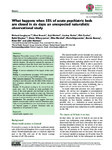What happens when 55% of acute psychiatric beds are closed in six days: an unexpected naturalistic observational study
| dc.contributor.author | Laugharne, R | |
| dc.contributor.author | Branch, M | |
| dc.contributor.author | Mitchell, A | |
| dc.contributor.author | Parkin, L | |
| dc.contributor.author | Confue, P | |
| dc.contributor.author | Shankar, Rohit | |
| dc.contributor.author | Wilson-James, D | |
| dc.contributor.author | Marshall, M | |
| dc.contributor.author | Edgecombe, M | |
| dc.contributor.author | Keaney, B | |
| dc.contributor.author | Gill, K | |
| dc.contributor.author | Harrison, J | |
| dc.date.accessioned | 2021-05-23T10:52:21Z | |
| dc.date.available | 2021-05-23T10:52:21Z | |
| dc.date.issued | 2016-10 | |
| dc.identifier.issn | 2054-2704 | |
| dc.identifier.issn | 2054-2704 | |
| dc.identifier.uri | http://hdl.handle.net/10026.1/17197 | |
| dc.description.abstract |
<jats:sec><jats:title>Objective</jats:title><jats:p> The sudden closure of 30 out of 54 acute psychiatric beds in Cornwall presented a stressful challenge to staff but also a natural experiment on how a service dealt with this situation. We aimed to evaluate the outcomes of patients needing to leave the closed ward, how bed occupancy rates were affected and the impact on admission rates. </jats:p></jats:sec><jats:sec><jats:title>Design</jats:title><jats:p> A service evaluation of the impact of the ward closure. </jats:p></jats:sec><jats:sec><jats:title>Setting</jats:title><jats:p> A comprehensive secondary NHS mental health service in Cornwall serving 550,000 population. </jats:p></jats:sec><jats:sec><jats:title>Main outcome measures</jats:title><jats:p> The destination of the patients needing to leave the acute unit, the effect of the closure on bed occupancy, admission rates and serious untoward incidents. </jats:p></jats:sec><jats:sec><jats:title>Results</jats:title><jats:p> Of 26 patients needing to be moved from the acute ward, only 10 needed an acute psychiatric bed. None of the seven patients who had been on the ward longer than nine weeks needed an acute unit. Admission rates fell over the subsequent three months. There was no increase in serious incidents due to the closure. </jats:p></jats:sec><jats:sec><jats:title>Conclusions</jats:title><jats:p> This naturalistic event suggests that many patients on acute units could be cared for elsewhere, especially recovery/rehabilitation care environments, if political and financial urgency is present. Admission rates are responsive to the pressure on beds. </jats:p></jats:sec> | |
| dc.format.extent | 205427041664928-205427041664928 | |
| dc.format.medium | Electronic-eCollection | |
| dc.language | en | |
| dc.language.iso | eng | |
| dc.publisher | SAGE Publications | |
| dc.rights | Attribution-NonCommercial-NoDerivatives 4.0 International | |
| dc.rights | Attribution-NonCommercial-NoDerivatives 4.0 International | |
| dc.rights | Attribution-NonCommercial-NoDerivatives 4.0 International | |
| dc.rights | Attribution-NonCommercial-NoDerivatives 4.0 International | |
| dc.rights.uri | http://creativecommons.org/licenses/by-nc-nd/4.0/ | |
| dc.rights.uri | http://creativecommons.org/licenses/by-nc-nd/4.0/ | |
| dc.rights.uri | http://creativecommons.org/licenses/by-nc-nd/4.0/ | |
| dc.rights.uri | http://creativecommons.org/licenses/by-nc-nd/4.0/ | |
| dc.subject | inpatient care | |
| dc.subject | mental health | |
| dc.title | What happens when 55% of acute psychiatric beds are closed in six days: an unexpected naturalistic observational study | |
| dc.type | journal-article | |
| dc.type | Journal Article | |
| plymouth.author-url | https://www.ncbi.nlm.nih.gov/pubmed/27757241 | |
| plymouth.issue | 10 | |
| plymouth.volume | 7 | |
| plymouth.publication-status | Published | |
| plymouth.journal | JRSM Open | |
| dc.identifier.doi | 10.1177/2054270416649280 | |
| plymouth.organisational-group | /Plymouth | |
| plymouth.organisational-group | /Plymouth/Faculty of Health | |
| plymouth.organisational-group | /Plymouth/Users by role | |
| dc.publisher.place | England | |
| dc.identifier.eissn | 2054-2704 | |
| dc.rights.embargoperiod | Not known | |
| rioxxterms.versionofrecord | 10.1177/2054270416649280 | |
| rioxxterms.licenseref.uri | http://creativecommons.org/licenses/by-nc-nd/4.0/ | |
| rioxxterms.type | Journal Article/Review |



